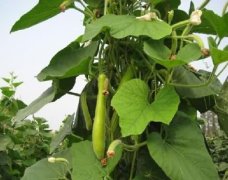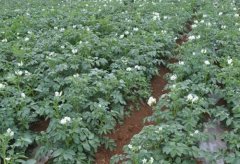Chestnut pumpkin planting method: does pumpkin need pollination? Control of pumpkin powdery mildew
In the cultivation of chestnut pumpkin, the seeds should be sterilized, then incubated and germinated, and then placed in a nursery pot containing culture soil. Cotyledons and two native leaves can be planted. It sprouted in a week, and he was planted in a nursery pot and planted in the soil in more than a week. Compared with native pumpkins, the planting of chestnut pumpkins is indeed more delicate and pink.
1. Sowing in winter, cold weather, not easy to germinate, seed epidermis has not germinated easily infected with mold, although does not affect germination, but it is best to sterilize to avoid. Later, I found that there was no need for tedious processes such as sterilization and nursery pots. My second batch of seeds were directly thrown into the rotten soil and watered and covered. Not only was there no mold, but they germinated as usual.
two。 Because the chestnut pumpkin seed is much larger than the general native pumpkin, the seed coat is also thick, it is not easy to germinate. It was said on the Internet that the seed skin could be peeled off and it germinated quickly. I didn't try! Because I think this is the natural mechanism of plants, if we change the time, let him wake up for a shorter period of time and sprout, and be rashly awakened to grow up, will there be any adverse effects? (! I think too much)
3. After observation and comparison, the effect of planting with vertical double vines is better, because the peel of chestnut pumpkin is delicate, even if lying on the ground is high, but there are still a lot of insect pests and snail bites (as shown below). Unlike upright cultivation, it can avoid ground pests and grow rapidly after pollination.
4. Chestnut pumpkin flowers, regardless of gender, are opened up, rainy days become a large cup, filled with a full cup of Rain Water, soaked in stamens or stigmas, will make pollination failure, so it is best to cover the flowers that will bloom the next day with plastic bags to avoid getting into the water.
5. After pollination, the female flower must be immediately wrapped in an elastic mesh Polaroid with fruit (the bag for buying guava apples should be reserved for Europe) so that it will not be bitten by fruit flies (the bag is too thin with other mesh bags, fruit flies can get in!) After two weeks of early growth, the net is opened and shaped, and other protective measures are taken.
6. Regardless of single vine or double vine cultivation, all other lateral vines need to be removed, leaving 2-3 fruits in single vines, at most two fruits in each vine, and picking hearts in the last five sections of the last fruit (I tried, not necessarily). After pollination, all the unopened male buds should be removed so that nutrients will not be wasted. In the picture below, double vines are cultivated on a vertical vane (dude, you seem to have a lot of vines!). I have more leaves for photosynthesis.
7. For the prevention and treatment of powdery mildew, if the disease occurs in the small plant, there is probably no need to save it. Even if it is cured, the plant is not strong. If it occurs in the middle and later stage of flowering, it can be sprayed with organic fungicides, Bordeaux liquid, sunflower dew or lime-sulfur mixture (calcium polysulfide). And remove 8. Seriously diseased leaves and old leaves. I bought calcium polysulfide in the chemical materials industry, the effect is very good, can be sterilized and stumbling, the preparation method can also be found on the Internet to cook by themselves.
9. In general, melons and fruits pay great attention to fertilizer, so as the result increases, it is necessary to apply additional fertilizer. His root system is very developed, as long as around 30 centimeters outside the circle to dig soil and bury fertilizer, you can get good results. Vertical cultivation is better to apply fertilizer.
As for the planting season, it is still being tested. In fact, I think the planting method is easier to manage than native pumpkins. (postscript: winter is the better planting season. Farmers plant after autumn and harvest in spring, because when the weather turns hot in May, the fruit stops growing.)
Although chestnut pumpkins are delicious, they are not resistant to diseases and insect pests because of exotic species. It is speculated that farmers should spray a lot of pesticides in order to avoid insect pests. In particular, this melon should be eaten without peeling, so you should be cautious! If you are not sure to grow it organically or by yourself, it is better to eat native pumpkins.
- Prev

What is a flat cattail? How to pick the heart and prune the bottle gourd
Flat cattail is also called bottle gourd. Flat cattail is a very popular vegetable. Do you know how it is grown? Do you want to know about it? 1. Cultivation season: although Prunus mandshurica can be cultivated all the year round in Taiwan, March-April in the north-central part and December-the following year in the south
- Next

Planting Technology and Management of Autumn Potato: the Best time for Autumn Potato planting
Do you want to grow potatoes in autumn? Then you have to understand the planting technology and management of autumn potatoes. Do you want to know? Let's get to know it. Sowing and transplanting 1. The sowing date is determined: according to the climatic conditions of Pingnan County, the sowing date of autumn potato should be about August. Suitable
Related
- The first cup of black tea in spring, the flavor and history of tea gardens in Kenya, Africa
- The computer can not only choose potatoes, but also grow tea rice. AI will grow winter oolong tea champion.
- It is not only the inflated tea bitten by insects, but also engraved with the four seasons tea in Beipu.
- The Oriental Beauty Tea Festival in Zhuxian County takes the stage at the weekend to experience the plus-size feast of oil tea.
- & quot; Oriental Beauty Tea & Exploration of Emei in Hsinchu, the hometown of quot;
- The new variety of strawberry "Tainong 1" dessert is the first choice with mellow aroma. Crimson gorgeous
- History of Tea in Taiwan: from Wild Inner Mountain to Export Tea Garden
- Two types of Taiwan Oriental Beauty Black Tea won the British three-Star Award for Childhood Tea Xiang Zhang Jiaqi changed from pilot to champion tea maker.
- Banana species and varieties: the planting history of Taiwan Xianren banana and dwarf banana is long, is banana disease resistant?
- Coffee planting Technology: Qianjie Coffee from Seedling to harvesting

